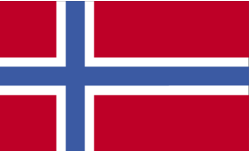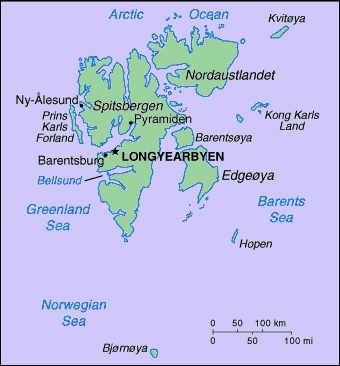Traveling Luck for Svalbard and Jan Mayen. Svalbard and Jan Mayen, Europe
Svalbard is located in Northern Europe, islands between the Arctic Ocean, Barents Sea, Greenland Sea, and Norwegian Sea, north of Norway.
Land in Svalbard is wild, rugged mountains; much of high land ice covered; west coast clear of ice about one-half of the year; fjords along west and north coasts.
land covers an area of 62049 square kilometers which is slightly smaller than West Virginia
 national flag (Flag of Svalbard and Jan Mayen)
national flag (Flag of Svalbard and Jan Mayen)
As for the climate; arctic, tempered by warm North Atlantic Current; cool summers, cold winters; North Atlantic Current flows along west and north coasts of Spitsbergen, keeping water open and navigable most of the year.
speak Norwegian, Russian.
Places of note in Svalbard and Jan Mayen
 map
map
Regions of Svalbard and Jan Mayen
First discovered by the Norwegians in the 12th century, the islands served as an international whaling base during the 17th and 18th centuries. Norway's sovereignty was recognized in 1920; five years later it officially took over the territory.
Coal mining is the major economic activity on Svalbard. The treaty of 9 February 1920 gives the 41 signatories equal rights to exploit mineral deposits, subject to Norwegian regulation. Although US, UK, Dutch, and Swedish coal companies have mined in the past, the only companies still mining are Norwegian and Russian. The settlements on Svalbard are essentially company towns. The Norwegian state-owned coal company employs nearly 60% of the Norwegian population on the island, runs many of the local services, and provides most of the local infrastructure. There is also some hunting of seal, reindeer, and fox.
natural resources include coal, iron ore, copper, zinc, phosphate, wildlife, fish
northernmost part of the Kingdom of Norway; consists of nine main islands; glaciers and snowfields cover 60% of the total area; site of future seed repository under construction by the Global Crop Diversity Trust and the Norwegian Government
religion is null.
Natural hazards in Svalbard include ice floes often block the entrance to Bellsund (a transit point for coal export) on the west coast and occasionally make parts of the northeastern coast inaccessible to maritime traffic.

 Search
Search